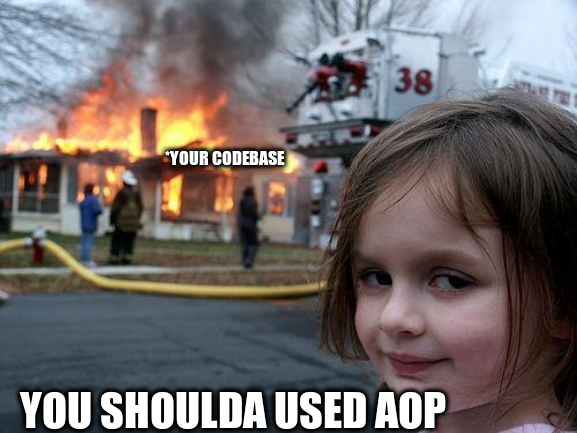In a medium to large codebase, many-a-time, you might notice code that shouldn’t be in some class/method by design but is necessary. This can be anything from simple logging to transaction handling. As the codebase scales, this keeps adding up to a point where the code becomes laborious to manage.

Aspect-Oriented Programming provides a way to modularize these kinds of cross-cutting concerns with Aspects. Here is a basic example,
@Aspect
class LoggingAspect { // Aspect
Logger LOGGER = Logger.getLogger(LoggingAspect.class.getName());
@After("execution(* *(..))") // Pointcut
void logExecutionAdvice(JoinPoint joinPoint) { // Advice
LOGGER.info(joinPoint.getSignature().getName() + " executed");
}
}
Aspect
An Aspect is a special class that contains the cross-cutting concerns. In Java, this can be created using annotations, like as above, or by using the non-java aspect format.
Pointcut
A pointcut is a special regex-like string that is used to specify where to inject your code. This can be any point in the program’s execution (a.k.a the joinpoint). A Joinpoint could be a method-body, a method-call, an exception handler, a class, an object, etc.
Advice
An advice contains the cross-cutting logic. Based on when to execute, it can be one of the below:
| Advice Type | Description |
|---|---|
| Before | Runs before the joinpoint’s execution. |
| After | Runs after the joinpoint’s execution. |
| AfterReturning | Runs after the successful execution of the joinpoint. |
| AfterThrowing | Runs after the joinpoint if it throws an exception. |
| Around | Gives the before and after control to the advice. |
Here is a more complex example that you might see in a production environment:
@Aspect
class TransactionAspect {
@Around("@annotation(com.example.Transaction)") // Injects to joinpoint with @Transaction annotation
public Object transactionAdvice(ProceedingJoinPoint joinPoint) throws Throwable {
Object result;
try {
TransactionManager.begin();
Object result = joinPoint.proceed(); // execution returns to the joinpoint
TransactionManager.commit();
} catch (Exception e) {
TransactionManager.rollback();
throw e;
}
return result;
}
}
The above example runs the @Transaction annotated methods in a transaction.
Weaving
Weaving is the process of injecting cross-cutting concerns into joinpoints. Based on when it is done, it is classified into of the following:
| Weaving Type | Description |
|---|---|
| Runtime Weaving | The advice is injected at runtime. Frameworks like Spring AOP use proxies to achieve this and are comparatively slower. |
| Compile Time Weaving | The advice is injected during compilation. Frameworks like AspectJ have their own compiler to achieve this. |
| Binary Weaving | The injection is done after compilation, i.e., into class/jar files. |
| Load Time Weaving | The injection is done when the classes are loaded by the classloader. Frameworks like AspectJ use a javaagent to achieve this. |
Hope this gave you a basic idea of what AOP can do and all its terminologies. So long!
